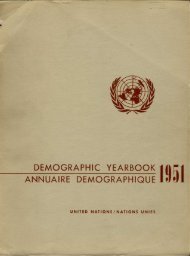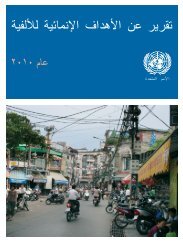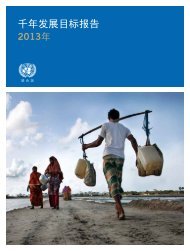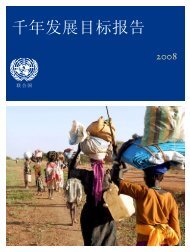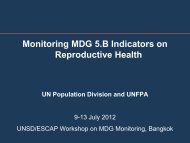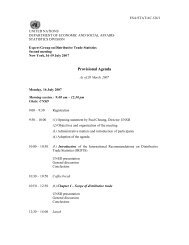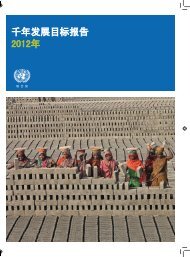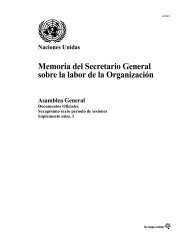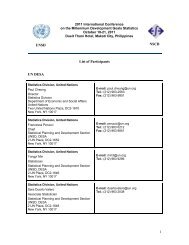V. ASSESSING GATS TRADE IN SERVICES A. Introduction B. The ...
V. ASSESSING GATS TRADE IN SERVICES A. Introduction B. The ...
V. ASSESSING GATS TRADE IN SERVICES A. Introduction B. The ...
Create successful ePaper yourself
Turn your PDF publications into a flip-book with our unique Google optimized e-Paper software.
Annotated Outline Chapter 5<br />
V. <strong>ASSESS<strong>IN</strong>G</strong> <strong>GATS</strong> <strong>TRADE</strong> <strong>IN</strong> <strong>SERVICES</strong><br />
In-depth discussion on how to measure trade in services by mode of supply presents links between<br />
statistical frameworks and modes of supply using clear-cut examples as well as borderline cases to<br />
show that modes of supply are asymmetrical.<br />
[question of local consumption of services by resident foreign-owned enterprises – mode 2? ]<br />
A. <strong>Introduction</strong><br />
<strong>GATS</strong> modes of supply, links with statistical frameworks, reasons for the development of a statistical<br />
framework for measuring <strong>GATS</strong> mode 4<br />
B. <strong>The</strong> <strong>GATS</strong> four modes of supply<br />
1. What are modes of supply: the <strong>GATS</strong> framework<br />
<strong>The</strong> <strong>GATS</strong> definition of services trade, modes of supply,.... including examples.<br />
[box on the commercial linkages between modes of supply, difficulties to clearly identify<br />
modes in transactions]<br />
[Local consumption of services by foreign affiliates in the host country?]<br />
[Should a box regarding the <strong>GATS</strong> definition of Mode 3 be included here – e.g. control defined by<br />
<strong>GATS</strong>?]<br />
[Shouldn't the definition of Mode 4, temporary, etc, be included here rather than later in the chapter?<br />
2. <strong>GATS</strong> mode 4<br />
Why mode 4 is a more complex issue: the need to explain the coverage of mode 4 in more detail.<br />
Defining <strong>GATS</strong> mode 4: <strong>GATS</strong> definition and the Annex, putting this in perspective of (and clearly<br />
distinguishing it from) the broader framework on movement of persons (see annex...)<br />
o What is a natural person?<br />
o Which skill levels are covered?<br />
o<br />
o<br />
What is temporary?<br />
Which categories of entrants are covered?<br />
(contractual service suppliers and independent professionals are central for mode 4, links of<br />
ICoTs and BVs with other modes of supply)<br />
o Summary (mainly box included in paper for TSG of February 06)<br />
[UNCTAD: Need to clarify mode 4 coverage: actual (i.e., what is already there/happening) and potential<br />
(what is foreseen, what could still be included?, how these categories fall within categories defined in the<br />
statistical framework?)]<br />
C. Measuring modes of supply<br />
This section will outline suggestions as to how an approximate picture of the value of transactions and<br />
other indicators by mode of supply may be built up.<br />
1. Information needs for assessing trade broken down by modes of supply<br />
Including small description in terms of breakdowns and classifications (notably services breakdown)<br />
[Are there other breakdowns that need to be added?]<br />
(a) Value of trade<br />
This is central to measure trade.<br />
(b) Needs related to market access and analysis<br />
Number of persons for mode 4, FDI for mode 3, etc.<br />
[Other needs?]
[Is it worth to mention links between modes and an ownership-based concept of trade that US and<br />
Australia have experimented with? Or might that fit better in an analytical annex?]<br />
2.Value of trade by modes of supply<br />
(a) Statistical treatment of modes of supply: difficulties and the simplified approach<br />
<strong>The</strong>re is no one-to-one relationship between sales and modes of supply of a service. A single services<br />
contract may involve a combination of modes.<br />
[Remind that it is to countries to do this exercise as not all have the same needs regarding all this. This is<br />
just a guide (e.g. Singapore).]<br />
[Do we need to revise the simplified statistical criteria in the light of mode 2 consumption of foreign<br />
firms?].<br />
(b) <strong>GATS</strong> modes of supply and EBOPS<br />
<strong>The</strong> discussion should not be limited to BPM5 items. And linked to the more detailed analysis of<br />
EBOPS items which will be included in Chapter 3. In the context of mode 4 the clear and objective<br />
criteria for recording transactions as service transactions or compensation of employees should be<br />
repeated (see chapter 3).<br />
[Given the changes in the BPM classification of services and the fact that a growing number of countries<br />
are providing more detailed trade in services statistics, should a simplified approach go into more detail in<br />
terms of services items? Should it also include a very simple approach as a first step (according to 11 + 1<br />
components)? Or should it combine both? Should also consider processing of goods]<br />
o IAM/EBOPS services components corresponding to mode 1<br />
[Should the use of statistics on wholesale margins (e.g. US experience), merchanting if estimated<br />
be mentioned?] [Shall we include more detail?]<br />
o IAM/EBOPS services components corresponding to modes 1 and 4<br />
[Shall we include more detail?] [Statements are also valid for construction. How could we<br />
combine both? Should we add more on employee/self-employed differences as included in<br />
"Background note on <strong>GATS</strong> mode 4 measurement" (see box. 1)? and on difficulties to<br />
differentiate both in certain cases and why we would rather go for services transactions and not<br />
employment-related flows?]<br />
o IAM/EBOPS services components corresponding to mode 2<br />
[Does TSA have anything to offer in terms of a more detailed breakdown of services (linked<br />
to BPM6/EBOPS classification)?] [question of local consumption of services by resident<br />
foreign-owned enterprises – mode 2?]<br />
o An exception: IAM/EBOPS mode 3 and mode 4 transactions in construction services<br />
[Shall we say more on other types of short-term arrangements which could be considered as<br />
commercial presence (e.g. consulting, maintenance, training, technical assistance, and health<br />
care)? But probably less of an issue for the simplified approach.]<br />
o Developing practices to separately identify modes of supply information within IAM/EBOPS<br />
services transactions<br />
[UNCTAD comment to consider: <strong>The</strong> options offered appear complementary so perhaps they<br />
could be merged in some ways. Option (c) could be a good starting point but as mentioned this<br />
could be costly and burdensome. It would be helpful to gather representatives from national<br />
statistics office, company representatives, immigration officials (particularly those in charged with<br />
visa) for an exchange of information on how best to go about the process of collecting<br />
information: i.e., both substantive- and procedure-wise.]<br />
(c) <strong>GATS</strong> mode 3 and sales of foreign affiliates<br />
FATS statistics and commercial presence: sales, value added<br />
[Should this section be further developed?, e.g. +wholesale margins if estimated (see U.S: experience)]
(d) <strong>GATS</strong> mode 4 and remittances of self-employed service suppliers<br />
[Should this section include some explanation on compensation of employees in the case of selfemployed<br />
persons, i.e. to determine if an employer-employee relationship exists? Should there be clearer<br />
and precise guidelines to define if an employee-employer relationship exists?]<br />
3. Indicators related to market access and analytical needs<br />
(a) <strong>GATS</strong> modes and FDI/FATS<br />
FDI flows and stocks, other FATS variables (for mode 4 number of employees and compensation, for<br />
mode 3 number of enterprises, etc.)<br />
(b) <strong>GATS</strong> mode 4 and UN Recommendations on Statistics of International Migration<br />
[Should we extend this work and investigate how categories of interest to mode 4 could be added within<br />
this statistical framework, and how the gaps could be filled in?<br />
What would be the best source(s) for collecting information on stocks and flows of persons in the context<br />
of <strong>GATS</strong> mode 4?<br />
How can we advance the work for identifying possibilities within existing statistical frameworks and<br />
sources (UNWTO provided a proposal to add appropriate questions to the model border survey)?]<br />
[+ box on data sources for mode 4: Border and passenger surveys (interesting source to<br />
obtain overall totals); Residence permit systems: visas and work permits (more detailed but is<br />
it more complete? Should continue to investigate this, for example <strong>GATS</strong> visa); Enterprise<br />
surveys (links with data collected for BoP purposes); Other sources (population censuses and<br />
household surveys, other relevant information: sectoral statistics from ministries, professional<br />
registers and companies)]<br />
[However, the TSG agreed that data sources for these variables need to be further discussed.<br />
Input of appropriate experts is necessary to further advance this work.]<br />
(c) Other indicators<br />
quantitative indicators, etc.<br />
[How much should we provide in this section?...specific text on infrastructure services?]<br />
[Should we add a box on What happens when several members are involved in the supply of a service? i.e.<br />
with an affiliate involved to illustrate that modes of supply may be asymmetrical depending on the point of<br />
view adopted? (see the background note)]<br />
D. Summary of recommendations<br />
This is not top priority. Very difficult to establish, need for analysis for countries which have a<br />
particular interest in mode 4, etc. This section could also include a summary matrix about modes of<br />
supply and how to link to statistics in terms of both the actual measurement of trade in services and<br />
for supplementary information of analytical interest (market access information, etc.)




